When most travelers dream of Morocco, Marrakech inevitably comes to mind first—the bustling souks, iconic Majorelle Gardens, and endless Instagram opportunities. But limiting your Moroccan adventure to this single destination means missing out on the country’s incredible depth and diversity. As a woman who has called Morocco home for years, I’m here to guide you beyond the well-trodden tourist paths to discover underrated Moroccan cities that offer authentic cultural immersion, fascinating historical sites, and warm hospitality—often with fewer crowds and more genuine connections.
What Makes a Moroccan City Culturally Rich?
Before exploring our hidden Morocco cities, let’s understand what creates the unique cultural fabric that makes these destinations so special. Morocco sits at a geographical crossroads where Amazigh (Berber), Arab, European, and Sub-Saharan African influences converge. This rich tapestry reveals itself through:
- Architectural heritage: From ancient kasbahs and medinas to colonial-era buildings
- Culinary traditions: Regional specialties that tell stories of trade routes and invasions
- Artistic expressions: Craftsmanship passed down through generations
- Historical significance: Each city’s unique role in shaping Morocco’s past
- Living traditions: Cultural practices that continue to thrive in daily life
What makes these underrated Moroccan cities particularly rewarding for women travelers is the opportunity to connect with local communities—especially Moroccan women—in ways that feel authentic rather than transactional. Many of these cities offer female-focused experiences like cooking classes, hammam visits, and textile cooperatives run by women.
Now, let’s explore seven gems that deserve a place on your Moroccan itinerary.
7 Underrated Moroccan Cities to Add to Your Itinerary
1. Chefchaouen: The Blue Pearl of Morocco
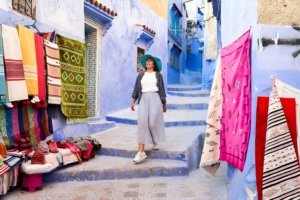
Why visit: Beyond the Instagram-famous blue streets, Chefchaouen offers a relaxed atmosphere that many women travelers find refreshing after the intensity of larger Moroccan cities. Nestled in the Rif Mountains, this hidden Morocco city delivers stunning natural beauty alongside its picturesque medina.
Cultural highlights: The local Amazigh culture is strong here, evident in the distinctive textiles and handicrafts. The blue-washed buildings themselves tell a story—theories about their color range from Jewish influence to keeping mosquitoes away.
Women-friendly experiences: Chefchaouen feels notably comfortable for female travelers, with less persistent attention than in major tourist centers. Seek out women’s weaving cooperatives where you can learn about traditional textile arts and support local female artisans.
Don’t miss: Hiking to the Spanish Mosque at sunset for panoramic views, exploring the kasbah museum, and sampling the local goat cheese.
2. Tetouan: Where Andalusian and Moroccan Cultures Blend
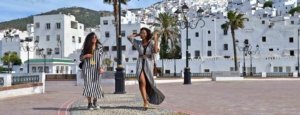
Why visit: Often overshadowed by nearby Tangier, Tetouan boasts one of Morocco’s most authentic and least touristy medinas. Its UNESCO World Heritage status recognizes the unique blend of Andalusian and Moroccan architectural styles, reflecting its history as a landing place for Muslims and Jews fleeing Spain.
Cultural highlights: Tetouan’s Royal Artisan School maintains centuries-old crafting traditions, while the archaeological museum houses remarkable artifacts from nearby Roman ruins. The city’s Spanish colonial architecture in the ensanche (new town) transports you to another era.
Women-friendly experiences: The Center of Art of Tetouan frequently features works by female Moroccan artists. The local hammams are less touristy than those in major cities, offering a more authentic experience.
Don’t miss: The Thursday market in Berber Souk, the ornate Mellah (Jewish Quarter), and the panoramic views from Sidi Al-Mandri tomb.
3. Moulay Idriss: Morocco’s Sacred City

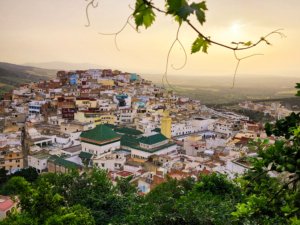
Why visit: Until 2005, non-Muslims couldn’t stay overnight in this sacred city, founded by Morocco’s first Arab ruler. Today, it remains one of the most fascinating yet underrated Moroccan cities for those interested in religious history and pilgrimage traditions.
Cultural highlights: As the burial place of Moulay Idriss I, who brought Islam to Morocco, the city hosts a significant moussem (religious festival) each August. The cylindrical minaret of the main sanctuary offers a unique architectural sight not common in Morocco.
Women-friendly experiences: Several local families offer cooking classes in their homes, providing insight into domestic life and culinary traditions. The Saturday souk brings women from surrounding villages selling handmade products.
Don’t miss: The panoramic viewpoint at the top of the town, the nearby Roman ruins of Volubilis, and sampling the local olive oil and nougat.
4. Asilah: Atlantic Charm with Artistic Flair
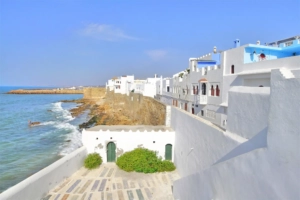
Why visit: This coastal gem combines whitewashed Mediterranean charm with Moroccan character. Less frequented by tourists than Essaouira, Asilah offers a laid-back atmosphere and remarkable street art.
Cultural highlights: Since 1978, the International Cultural Festival has transformed the medina into an open-air gallery, with murals created by artists from around the world. Portuguese fortifications frame stunning Atlantic views, while the old town’s architecture reflects multiple cultural influences.
Women-friendly experiences: Asilah’s relaxed coastal vibe makes it comfortable for female travelers. The city’s art scene includes several galleries showcasing women artists, and beach culture here is more progressive than in many Moroccan destinations.
Don’t miss: Paradise Beach (a short taxi ride away), sunset walks along the ramparts, and visiting during the cultural festival (usually August) to see artists at work.
5. Taroudant: The “Little Marrakech” Without the Crowds
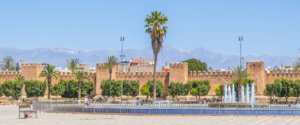
Why visit: Encircled by magnificent red-earth ramparts, Taroudant offers the cultural richness of Marrakech without the sensory overload. This hidden Morocco city in the fertile Souss Valley provides an authentic glimpse into everyday Moroccan life.
Cultural highlights: The souks here are for locals, not tourists, meaning authentic crafts at better prices. The city’s position between the Atlas and Anti-Atlas mountains made it historically significant as a trading post, evident in its diverse cultural influences.
Women-friendly experiences: Female travelers report comfortable interactions in Taroudant’s markets, with less aggressive selling tactics than in tourist centers. Several women’s argan oil cooperatives in the region offer tours and demonstrations.
Don’t miss: Cycling around the entire city walls at sunset, visiting the leather tanneries, and taking a day trip to nearby Paradise Valley.
6. Sefrou: Cherry Blossoms and Cultural Heritage

Why visit: Just 30 km from Fes but worlds away in atmosphere, Sefrou once had such significant Jewish and Muslim scholarly communities that it was called “Little Jerusalem.” Today, it’s known for its annual Cherry Festival, recognized by UNESCO as intangible cultural heritage.
Cultural highlights: The waterfall at the edge of the medina creates an unusual urban oasis. The city’s mellah (Jewish Quarter) architecture reveals the historical importance of Jewish culture here, with distinctive balconies and window designs.
Women-friendly experiences: The Cherry Festival each June crowns a “Cherry Queen” and celebrates female participation in public life. Local women’s cooperatives specialize in traditional button-making and embroidery.
Don’t miss: The Thursday souk, the Cave of Bhalil (where some locals still live in cave dwellings), and visiting during cherry season for the most delicious fruit.
7. Agadir: Modern Coastal Charm with Ancient Roots

Why visit: Rising from the ashes of a devastating 1960 earthquake, modern Agadir offers a unique contrast to Morocco’s ancient imperial cities. With its broad avenues, crescent beach, and year-round sunshine, this coastal gem provides a relaxed atmosphere many women travelers find refreshing.
Cultural highlights: While rebuilt as a modern city, Agadir maintains connections to its past through the hillside ruins of the ancient kasbah, the fascinating Souk El Had, and the Amazigh Heritage Museum showcasing the region’s indigenous culture.
Women-friendly experiences: Agadir’s status as an international tourism destination means a more relaxed social atmosphere where women can comfortably enjoy beach activities, outdoor cafés, and evening walks along the marina. The city’s Paradise Valley offers women-led argan oil cooperatives where you can learn about traditional production methods.
Don’t miss: The panoramic view from the kasbah ruins, the vibrant fish market, a day trip to nearby Paradise Valley with its natural pools, and the Sunday market in nearby Tikiouine for authentic local experiences.
Safety & Practical Travel Tips for Women
While these underrated Moroccan cities offer rich cultural experiences, responsible preparation enhances any woman’s journey through Morocco:
Cultural Respect
- Dress modestly, especially in smaller cities where conservative attitudes prevail (shoulders covered, loose clothing below the knees)
- Learn basic Arabic or French phrases—efforts to communicate are deeply appreciated
- Ask permission before photographing people, especially women
Safety Considerations
- Use registered taxis at night rather than walking alone
- Stay in riads or guesthouses with 24-hour reception
- Share your itinerary with someone at home
- Consider hiring local female guides for deeper cultural insights
Practical Matters
- Download maps for offline use as smaller cities may have limited signage
- Carry toilet paper and hand sanitizer for public restrooms
- Book accommodations in advance for hidden Morocco cities with limited tourist infrastructure
- Be prepared for ATMs to be scarce in smaller locations
Bonus Tips: Creating Your Perfect Moroccan Circuit
Suggested Routes
- Northern Circuit: Tangier → Tetouan → Chefchaouen → Asilah (10 days)
- Central Heritage Trail: Fes → Sefrou → Moulay Idriss → Meknes (1 week)
- South and Atlantic: Marrakech → Taroudant → Agadir → Essaouira (2 weeks)
Best Times to Visit Underrated Moroccan Cities
- Spring (March-May): Ideal temperatures and blooming landscapes, particularly beautiful in Sefrou during cherry season
- Fall (September-November): Pleasant weather with fewer tourists
- Winter (December-February): Mild in coastal cities like Agadir and Asilah but can be cold in mountain areas like Chefchaouen
- Summer (June-August): Very hot inland but perfect on coastal cities like Agadir; cultural festivals abound
Getting Around
While larger cities connect via comfortable trains, reaching these hidden Morocco cities often requires:
- Grand taxis (shared Mercedes services between cities)
- CTM or Supratours buses (reliable companies with scheduled services)
- Rental car (offers maximum flexibility but requires confident driving)
Conclusion: Your Authentic Moroccan Adventure Awaits
Morocco’s magic extends far beyond Marrakech’s famous Jamaa el Fna square. By venturing to these underrated Moroccan cities, female travelers discover the country’s soul through meaningful cultural exchanges, preserved historical treasures, and the legendary hospitality that makes Morocco truly special.
Each of these cities offers women travelers unique perspectives on Moroccan culture and history while providing more relaxed environments to connect with local communities. Whether you’re seeking artistic inspiration, historical insights, or simply a more authentic travel experience, these destinations deliver memorable encounters away from the tourist crowds.
Ready to explore off the beaten path Morocco? Which of these underrated gems will you visit first? Start planning your journey beyond the obvious and discover the Morocco that many travelers never see—but those who do, never forget.
[Explore our complete guide to Female Travel in Morocco →]
[Discover more about Fes and Tangier in our City Guides →]
